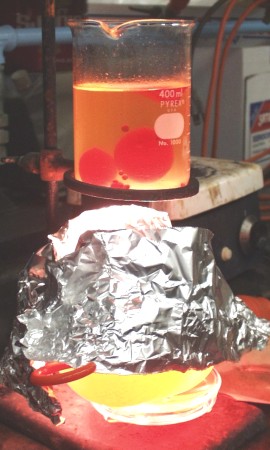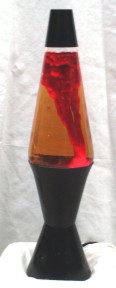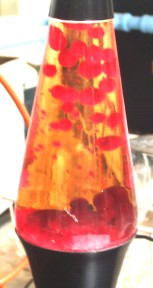

We set out to find a perfect homemade recipe that could be used in the lab to illustrate a variety of physical and chemical properties such as convection, solubility, surface tension, thermal expansion and density. After searching the net for recipes, we tried a mixture of mineral oil (lava) and isopropyl alcohol. This gave us reasonable results, but the isopropyl alcohol evaporates quickly and with heating it evaporates even more quickly. So, we tried the mixture shown above. It is a saturated sodium chloride/water solution with silicone oil as the lava. We used iodine to tint the silicone oil purple. A 60 watt light bulb was used to heat the solution, and a wire coil from a heating element was placed in the bottom of the beaker to help break the surface tension of the silicone oil so new blobs can form. As the light bulb heats the silicone oil, the density of the oil becomes less than the salt water and the oil rises to the top. We shielded the top of the beaker from the light to keep a temperature differential so that the lava would cool and become more dense. The density of the silicone oil becomes greater than the salt water and the silicone oil sinks. When picking ingredients, the densities need to be similar, and the coefficient of thermal expansion for the lava should be high relative to the surrounding liquid. Ideally, the mixture should be placed in a sealed container to prevent evaporation.
www.rose.cc.ok.us/faculty/gjackson/
- good information for many types of science demonstrations
- if you are looking for details on how a lava lamp works, this
is the place
- recipes for lava lamps (various difficulty levels)
www.oozinggoo.com
- formulas using mineral oil and alcohol, benzyl alcohol and water,
and kids version
- U.S. patent information
- purchase information
- help line (if your lamp isn't working)
www.forwiss.tu-muechen.de/~fenk/public/lavalamps/Lavalamps.html
- recipes that are similar to oozing goo
- some of the messages are in German
www.kids.infoplease.lycos.com/spot/lavalamp.html
- not a true motion lamp recipe, but a good (safe) experiment
for kids
www.amasci.com/amateur/lavalamp.html
- more guesses on how to make a lava lamp
www.straightdope.com/classics/a2_359.html
- Making a lamp isn't as easy as you think!
- contact information for a lava lamp producer in Chicago
www.pigseye.kennesaw.edu/~bwhyte/make.htm
- another mineral oil and isopropyl recipe
www.geocities.com/SoHo/1346
- Lava lamp conspiracy page



www.lavarind.sgi.com/datacenter.html
- extensive research on lava lamps
www.neuro.caltech.edu/~carol/lavascience.html
- more research
www.lavarind.sgi.com/care.html
- ways of making your lava lamp last longer
www.lavalites.com
- replacement parts and service info for Lava Liteâ brand
motion lamps
www.lavaworld.com
- Lavaâ brand official site for replacement parts and service
www.mathmos.co.uk
- British site for original lamps (replacement information)
www.listings.ebay.com/aw/plistings/list/all/category4052/
- E-bay's lava lamp category
www.lavalites.com
- Lava Lite brand motion lamps
- pricing information on lamps and replacement parts
www.allumination.co.nz/productguide/
- very unique (and expensive) motion lamps
www.finest1.com/lava
- HUGE lamps (27 in. tall, 8.5 in. diameter)
www.lavaworld.com
- Lava brand official site, Haggerty Enterprises owns the US patent
for the lava lamp
- excellent history of lava lamps (with pictures)
www.mathmos.co.uk
- British site for original lamps, they own the UK patent.
www.planet-pigeon.com/lava.shtml
- Amazing collection of lamps!
www.clark.net/web/lavalamps/
- even more lava lamp pages
www.inventors.about.com/science/inventors/library/weekly/aa092297.htm
- contains a history of Craven Walker, the man who first patented the lamp in England.
www.uspto.gov/patft/index.html
-you can see the original US patent (#3387396) through this search engine.
Site created by Stacy Swanson
Last updated: 4/18/01